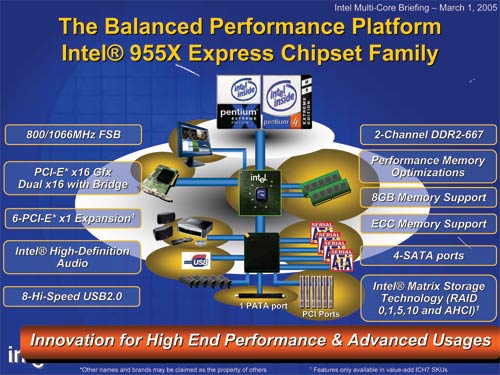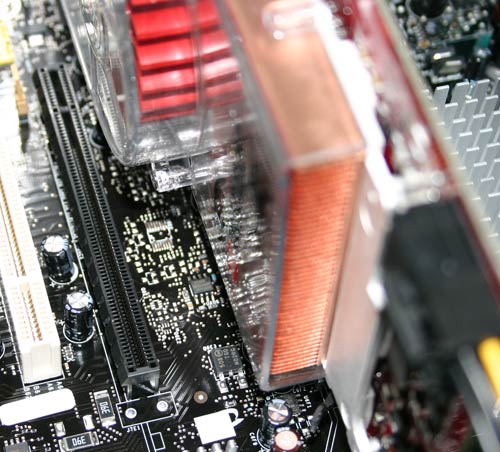Dual Core Intel Platform Shootout - NVIDIA nForce4 vs. Intel 955X
by Anand Lal Shimpi on April 14, 2005 1:01 PM EST- Posted in
- CPUs
Intel's 955X Chipset
With pricing out of the way, let's have a look at the 955X chipset itself. The Intel slide below provides a good overview of the chipset:

For the most part, the features are pretty straightforward, but there are a few interesting points. Note that Intel shows support for dual PCI Express x16 slots with the use of an external bridge, meaning that motherboard manufacturers could effectively offer SLI support on 955X platforms. We firmly believe that Intel will introduce support for SLI once both ATI and NVIDIA have introduced their SLI technologies. It has yet to be seen how Intel will implement this bridged dual x16 solution and whether it will be a true dual x16 setup, or two x8 slots like NVIDIA's SLI.

The board that we used for this review actually featured two x16 slots, but only one was a true x16 slot - the other was a x4 slot with a x16 connector.










96 Comments
View All Comments
xsilver - Thursday, April 14, 2005 - link
oh and before when you were arguing about heat --- if you didnt understand... let me translate the graph segagenesis providedamd 64 3500 at load = 114w
intel 550, 3.4ghz /load = 207w
that's close to DOUBLE power consumption with similar performance/price characteristics.
xsilver - Thursday, April 14, 2005 - link
#54I remember reading amd's 3 year roadmap right here on AT.... maybe you missed it
3 year roadmaps aren't very good anyways, they provide no real hard information.... what are you worried that amd isn't going to exist in 3 years???
what AT people here are arguing is about performance... now you have jumped from heat output to spelling to performance and now to company profile... please be concise
Questar - Thursday, April 14, 2005 - link
"The only defense I imagine he could possibly conjure up right now is currently in the market there is the "Nobody got fired for buying Intel" mentality where companies and such are wary of trying non-Intel products mainly because... Dell and other major manufacturers wont offer it in any quantity."Actually there are two reasons:
1) Qualification costs. it can be easy to drop $150k to qualify a new platform.
2) Product longevity. Change is very expensive to large corporations. Anything we make a commitment to buy must have a lifespan of at least 18 months from the date we qualify the product. We also must be comfortable with the companies 3 year product roadmap. So far there are no teir one vendors that have AMD product lines that meet these requirements.
Questar - Thursday, April 14, 2005 - link
NVIDIA changed the spelling of their name from nVidia to NVIDIA a few years ago, have a look at NVIDIA's home page for confirmation - http://www.nvidia.com/page/companyinfo.htmlQuestar: NVIDIA is the correct corporate capitalization of the company. I actually don't think I've ever seen it spelled "nVidia".
I stand corrected. Thank you.
glennpratt - Thursday, April 14, 2005 - link
I think you mean you disagree with his first statement, since his last statement was about DDR2. Personally, I assume reviews on this site are talking to me (PC enthusiast) and not businesses (except reviews which explicitly state otherwise which are few and far between here). In that context, Anand has a point.KristopherKubicki - Thursday, April 14, 2005 - link
Questar: NVIDIA is the correct corporate capitalization of the company. I actually don't think I've ever seen it spelled "nVidia".Kristopher
Motley - Thursday, April 14, 2005 - link
Perhaps it should have been worded differently like... offered performance benefits that have only yet to be realized. But as worded, it is misleading and incorrect. Obviously, I read your site often, and I have come to expect technical correctness in what you write ;-)That said, I still would have to disagree with your last statement. Where companies purchase and keep PC's around for 3+ years (OMG, I wish we got rid of PC's in 3 years), the ability to purchase PCI-E when it came out knowing that we could upgrade them to iSCSI, etc in the future *IS* a very tangable benefit. At home, it's a different story, where my motherboard changes with every major change (or every other as money permits).
BaronVonAwesome - Thursday, April 14, 2005 - link
You have to be leery of anyone who resorts to juvenile symantics in an argument. When Questar derided another person for using the word "worthless" to describe Intel, you had to ignore him. Obviously, "worthless" wasn't meant literally. That's one of the wonders of the English language, the way it evolves, with words taking on more subtle meanings through the gradual societal acceptance of colloquialisms and slang. Words like "worthless" also lose their qualitative and quantitative qualities through this evolution...depending on how the word is used of course. Generally, when people resort to literal symantics, they feel like they are losing the argument. Reminds me of when Bill Clinton questioned the definition of the word "is." Questar's back was against the wall, I guess.glennpratt - Thursday, April 14, 2005 - link
On another note will there be a non-SLI version of the nF4 Intel Ed.?glennpratt - Thursday, April 14, 2005 - link
Questar - This may have been said before, but I didn't read this whole thread.Reviews are generally filled with opinion, it's the nature of the beast. If you wanted an Intel white paper well this isn't the place for it. If you've taken a high school level english class then you should be quite capable of determining opinion from fact in common english.